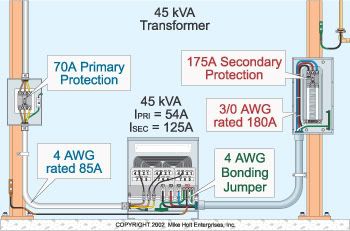The transformer may not need Sec OCPD (450) but the conductors do (240). Because the conductors do (240) the transformer table (450) caps the maximum size and 200A don't make it.
This is simply not correct. Whether or not the transformer secondary conductors require OCP, has
NOTHING to do with "Primary and Secondary" protection of the transformer per 450.3(B). 450.3 say "Overcurrent protection of
TRANSFORMERS shall comply with 450.3(A), (B), or (C)."
If the OCPD on the primary of the Transformer does not exceed 125% of the primary rated current (or next standard size up,) then the Transformer can be protected by "Primary Only Protection" per 450.3(B). The
secondary of the TRANSFORMER will NOT REQUIRE overcurrent protection, per 450.3(B). The secondary conductors will still need overcurrent protection in accordance with 240.21(C).
The OP asked if the install was legit. Not just the transformer.
Actually, he only asked about the transformer...
One more transformer protection question for the day
If he was asking about the complete install, you would think he would have let us know what the primary and secondary conductor sizes were. Without knowing the conductor sizes, there is no way to comment on the complete install.
Had he stated the secondary was 175A or less you'd be okay. Had he asked if transformers in general need secondaries then you'd be okay. But your advice is violating table 450.3(B) Note 2 as a cascade requirement from 240.
My advice is not violating table 450.3(B). Again, table 450.3(B) is for Transformer protection only, not conductors. Note 2 says "
where secondary overcurrent protection i
s required..."
Now look at Table 450.3(B) under protection method. It says "Primary only protection" and "Primary and secondary protection." Looking at the "Primary only protection" line under the "Primary Protection" column, you will see that the Maximum Setting for the primary will be 125% of the primary rated current, or the next standard size up. The 45kVA transformer has a primary rated current of 54A. 125% of that is 67.5A. 70A is the next standard size up from 67.5A. So by using a 70A primary c/b on the 45kVA transformer we do not exceed the maximum setting for "Primary only protection."
Next, continue along the "Primary only protection" row until you get to the "Secondary Protection" column. You will see "
Not Required."
Secondary protection of the TRANSFORMER is NOT REQUIRED, if the "primary only protection" provisions are met. Since a 70A primary OCPD meets the requirements for "primary only protection," the secondary conductors OCPD can be any size that you desire. The secondary conductors must have an ampacity that is greater to or equal to the secondary conductors OCPD per 240.21(C).
So...
In the OP, the 45kVA transformer with a 70A primary OCPD can have a 200A secondary conductor OCPD, but the conductors cannot be smaller than 3/0. It could have a 250A secondary conductor OCPD, but the conductors cannot be smaller than 250mcm, or it could have a 300A secondary conductor OCPD, but the conductors cannot be smaller than 350mcm, etc.
You did not "make the installation compliant" by only adjusting the primary.
Yes, you would make the installation compliant by
only adjusting the primary OCPD, assuming the conductors are already properly protected per 240.4 and 240.21(C).


